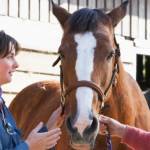Rabies in Horses and Mules

Thirty-seven confirmed cases of rabies were documented in horses and mules in the United States and Puerto Rico in 2010. The states with the most reported equine cases include Texas (8), Oklahoma (6), and Pennsylvania (5). For comparison, 71 cases of rabies were reported in cattle and 69 cases in dogs. Two cases of rabies were reported in humans. Skunks, raccoons, and foxes are important wild animal reservoirs of rabies virus in the continental United States.
Rabies is virtually 100% fatal, though fortunately vaccination is highly effective to prevent infection in exposed animals and preclude spread of the disease. Rabies is a core vaccination recommended for all horses by the American Association of Equine Practitioners (along with eastern and western equine encephalomyelitis, tetanus, and West Nile virus). Foals from vaccinated mares should be vaccinated against rabies no younger than 6 months of age and given a booster 4-6 weeks later. Foals from unvaccinated mares should be vaccinated at 3-4 months of age. Rabies vaccine should be boostered yearly.
Rabies virus is transmitted in saliva through bites, open wounds in skin, or onto mucous membranes such as the eyes or mouth. If a horse is exposed to a rabid animal, consult with your veterinarian regarding local regulations for isolation and observation requirements.








